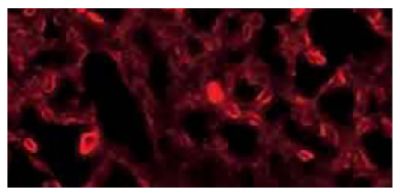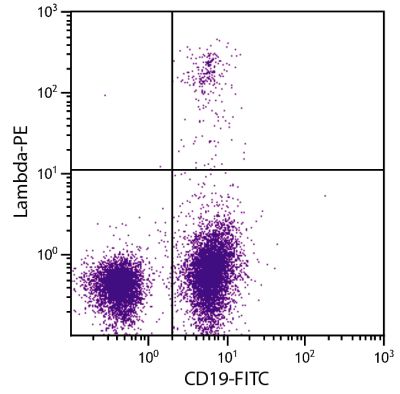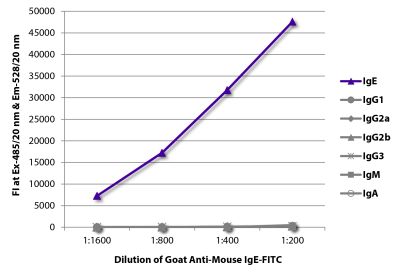Goat F(ab')2 Anti-Mouse IgG3, Human ads-FITC
Cat. No.:
1102-02
Goat F(ab')2 Anti-Mouse IgG3-FITC antibody with minimal reactivity to human proteins for use in flow cytometry and immunocytochemistry assays.
$249.00
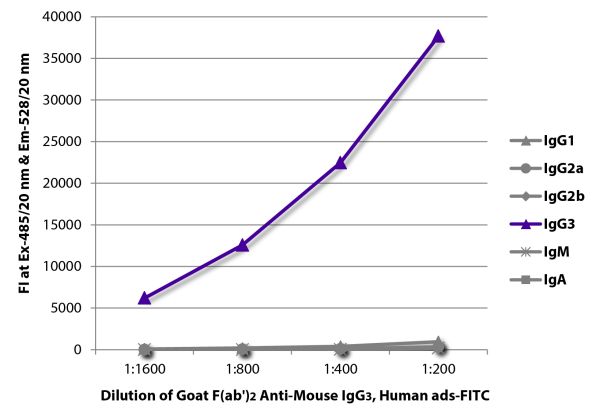

| Isotype | Goat F(ab')2 IgG |
|---|---|
| Isotype Control | Goat F(ab')2 IgG-FITC |
| Specificity | Reacts with the heavy chain of mouse IgG3 |
| Source | Pepsin digest of Goat Anti-Mouse IgG3, Human ads (SB Cat. No. 1100) |
| Cross Adsorption | Mouse IgG1, IgG2a, IgG2b, IgM, and IgA; human immunoglobulins and pooled sera; may react with immunoglobulins from other species |
| Conjugate | FITC (Fluorescein) |
| Buffer Formulation | Phosphate buffered saline containing < 0.1% sodium azide |
| Clonality | Polyclonal |
| Concentration | 0.5 mg/mL |
| Volume | 1.0 mL |
| Recommended Storage | 2-8°C; Avoid exposure to light |
| Applications |
Quality tested applications for relevant formats include - ELISA FLISA Flow Cytometry 1-17 Other referenced applications for relevant formats include - Immunocytochemistry 3,18 |
| RRID Number | AB_2794591 |
| Gene ID |
380795 (Mouse) |
| Gene ID Symbol |
Ighg3 (Mouse) |
| Gene ID Aliases | IgG3 |
| UniProt ID |
P03987 (Mouse |
| UniProt Name |
IGHG3_MOUSE (Mouse) |
Documentation
Certificate of Analysis Lookup
Enter the Catalog Number and Lot Number for the Certificate of Analysis you wish to view
- 1. Schrader CE, Edelmann W, Kucherlapati R, Stavnezer J. Reduced isotype switching in splenic B cells from mice deficient in mismatch repair enzymes. J Exp Med. 1999;190:323-30. (FC)
- 2. Lovchik JA, Wilder JA, Huffnagle GB, Riblet R, Lyons CR, Lipscomb MF. Ig heavy chain complex-linked genes influence the immune response in a murine cryptococcal infection. J Immunol. 1999;163:3907-13. (FC)
- 3. Hanon E, Stinchcombe JC, Saito M, Asquith BE, Taylor GP, Tanaka Y, et al. Fratricide among CD8+ T lymphocytes naturally infected with human T cell lymphotropic virus type I. Immunity. 2000;13:657-64. (FC, ICC)
- 4. Luby TM, Schrader CE, Stavnezer J, Selsing E. The μ switch region tandem repeats are important, but not required, for antibody class switch recombination. J Exp Med. 2001;193:159-68. (FC)
- 5. Carpenter MK, Rosler ES, Fisk GJ, Brandenberger R, Ares X, Miura T, et al. Properties of four human embryonic stem cell lines maintained in a feeder-free culture system. Dev Dyn. 2004;229:243-58. (FC)
- 6. Furukawa Y, Saito M, Matsumoto W, Usuku K, Tanaka Y, Izumo S, et al. Different cytokine production in tax-expressing cells between patients with human T cell lymphotropic virus type I (HTLV-I)-associated myelopathy/tropical spastic paraparesis and asymptomatic HTLV-I carriers. J Infect Dis. 2003;187:1116-25. (FC)
- 7. Goon PK, Igakura T, Hanon E, Mosley AJ, Barfield A, Barnard AL, et al. Human T cell lymphotropic virus type I (HTLV-I)-specific CD4+ T cells: immunodominance hierarchy and preferential infection with HTLV-I. J Immunol. 2004;172:1735-43. (FC)
- 8. Sánchez A, Factor VM, Schroeder IS, Nagy P, Thorgeirsson SS. Activation of NF-κB and STAT3 in rat oval cells during 2-acetylaminofluorene/partial hepatectomy-induced liver regeneration. Hepatology. 2004;39:376-85. (FC)
- 9. Hoffman LM, Hall L, Batten JL, Young H, Pardasani D, Baetge EE, et al. X-inactivation status varies in human embryonic stem cell lines. Stem Cells. 2005;23:1468-78. (FC)
- 10. Xu C, Rosler E, Jiang J, Lebkowski JS, Gold JD, O'Sullivan C, et al. Basic fibroblast growth factor supports undifferentiated human embryonic stem cell growth without conditioned medium. Stem Cells. 2005;23:315-23 (FC)
- 11. Forsyth NR, Musio A, Vezzoni P, Simpson AH, Noble BS, McWhir J. Physiologic oxygen enhances human embryonic stem cell clonal recovery and reduces chromosomal abnormalities. Cloning Stem Cells. 2006;8:16-23. (FC)
- 12. Delaleu N, Immervoll H, Cornelius J, Jonsson R. Biomarker profiles in serum and saliva of experimental Sjögren's syndrome: associations with specific autoimmune manifestations. Arthritis Res Ther. 2008;10:R22. (FC)
- 13. Guikema JE, Linehan EK, Tsuchimoto D, Nakabeppu Y, Strauss PR, Stavnezer J, et al. APE1- and APE2-dependent DNA breaks in immunoglobulin class switch recombination. J Exp Med. 2007;204:3017-26. (FC)
- 14. Guikema JE, Schrader CE, Leus NG, Ucher A, Linehan EK, Werling U, et al. Reassessment of the role of Mut S homolog 5 in Ig class switch recombination shows lack of involvement in cis- and trans-switching. J Immunol. 2008;181:8450-9. (FC)
- 15. Delaleu N, Madureira AC, Immervoll H, Jonsson R. Inhibition of experimental Sjögren's syndrome through immunization with HSP60 and its peptide amino acids 437-460. Arthritis Rheum. 2008;58:2318-28. (FC)
- 16. Guikema JE, Schrader CE, Brodsky MH, Linehan EK, Richards A, El Falaky N, et al. p53 represses class switch recombination to IgG2a through its antioxidant function. J Immunol. 2010;184:6177-87. (FC)
- 17. Schrader CE, Linehan EK, Ucher AJ, Bertocci B, Stavnezer J. DNA polymerases β and λ do not directly affect Ig variable region somatic hypermutation although their absence reduces the frequency of mutations. DNA Repair. 2013;12:1087-93. (FC)
- 18. Peng SL, Moslehi J, Craft J. Roles of interferon-γ and interleukin-4 in murine lupus. J Clin Invest. 1997;99:1936-46. (ICC)
See All References


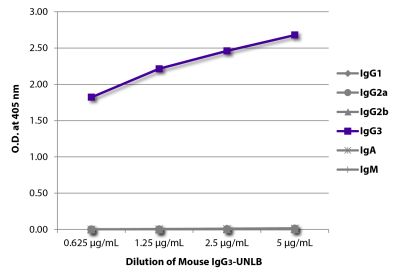
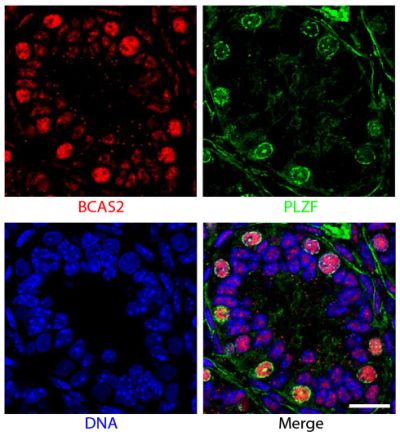
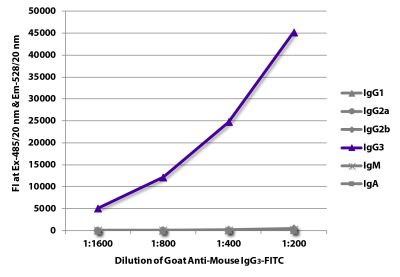
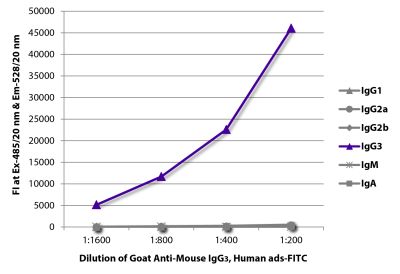
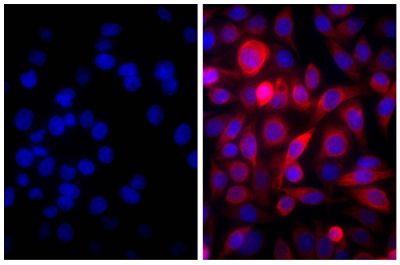
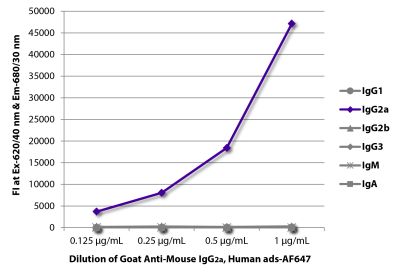
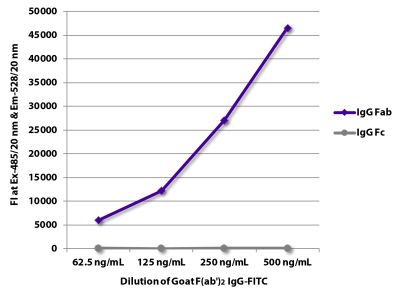
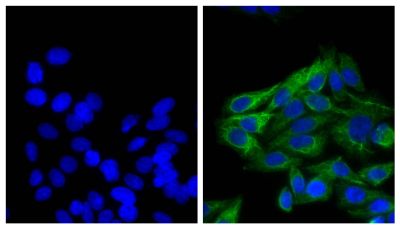
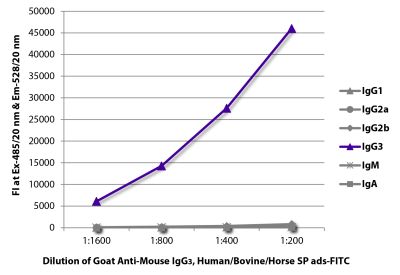
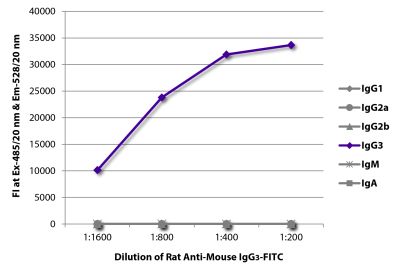
![Wdpks1Δ-1 yeast cells treated with liquid nitrogen were stained with anti-melanin followed by Goat Anti-Mouse IgM, Human ads-TRITC (SB Cat. No. 1020-03).<br/>Image from Paolo WF Jr, Dadachova E, Mandal P, Casadevall A, Szaniszlo PJ, Nosanchuk JD. Effects of disrupting the polyketide synthase gene <i>WdPKS1</i> in <i>Wangiella</i> [<i>Exophiala</i>] <i>dermatitidis</i> on melanin production and resistance to killing by antifungal compounds, enzymatic degradation, and extremes in temperature. BMC Microbiol. 2006;6:55. Figure 5(d)<br/>Reproduced under the Creative Commons license https://creativecommons.org/licenses/by/2.0/](https://www.southernbiotech.com/media/catalog/product/cache/3409635b2d8a6f8a49dab513db4d1386/e/1/e1bdcbb171112075fbda9bda20f45e7e878c207c8caf1773ba0e0bf58185d151.jpeg)
